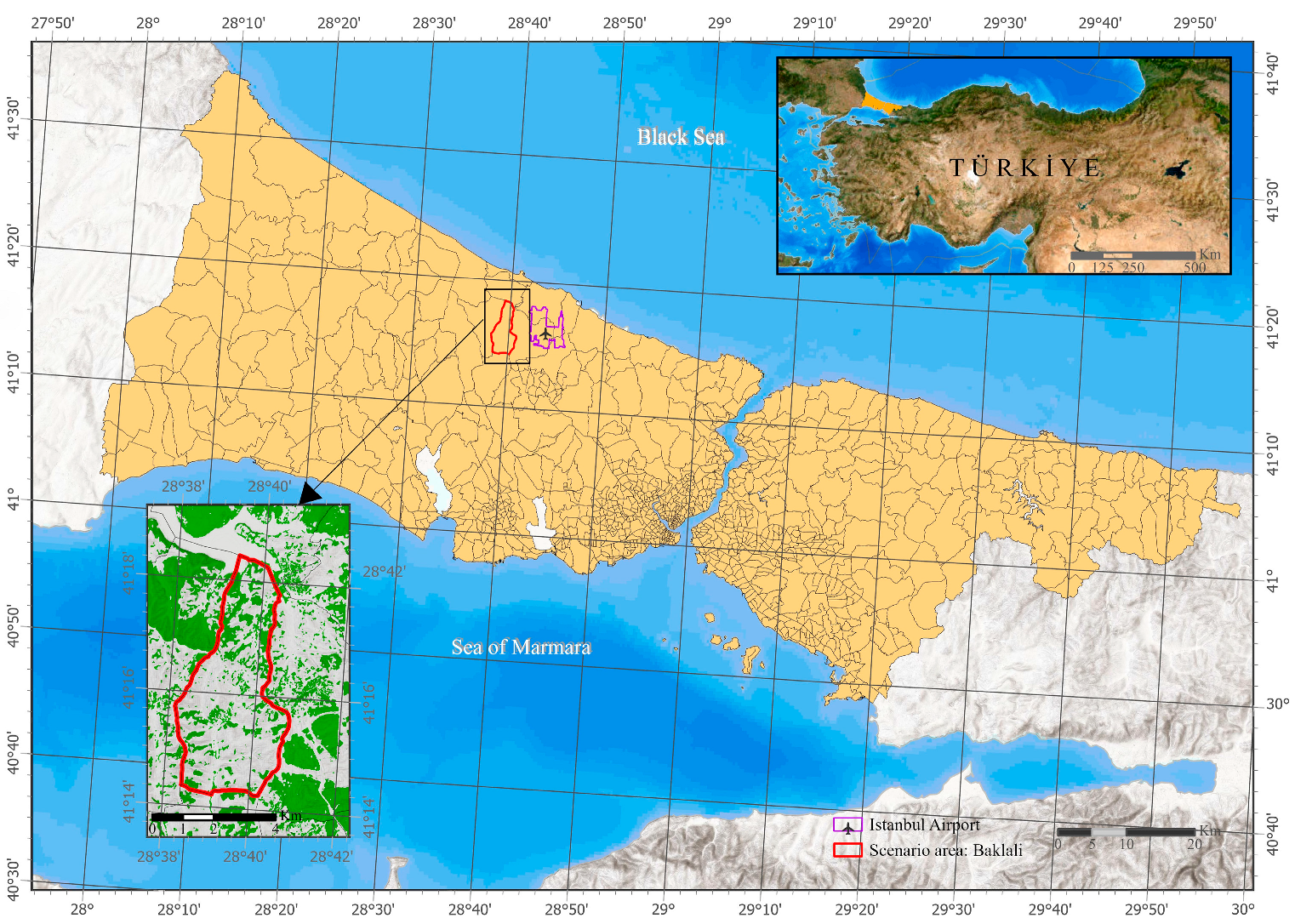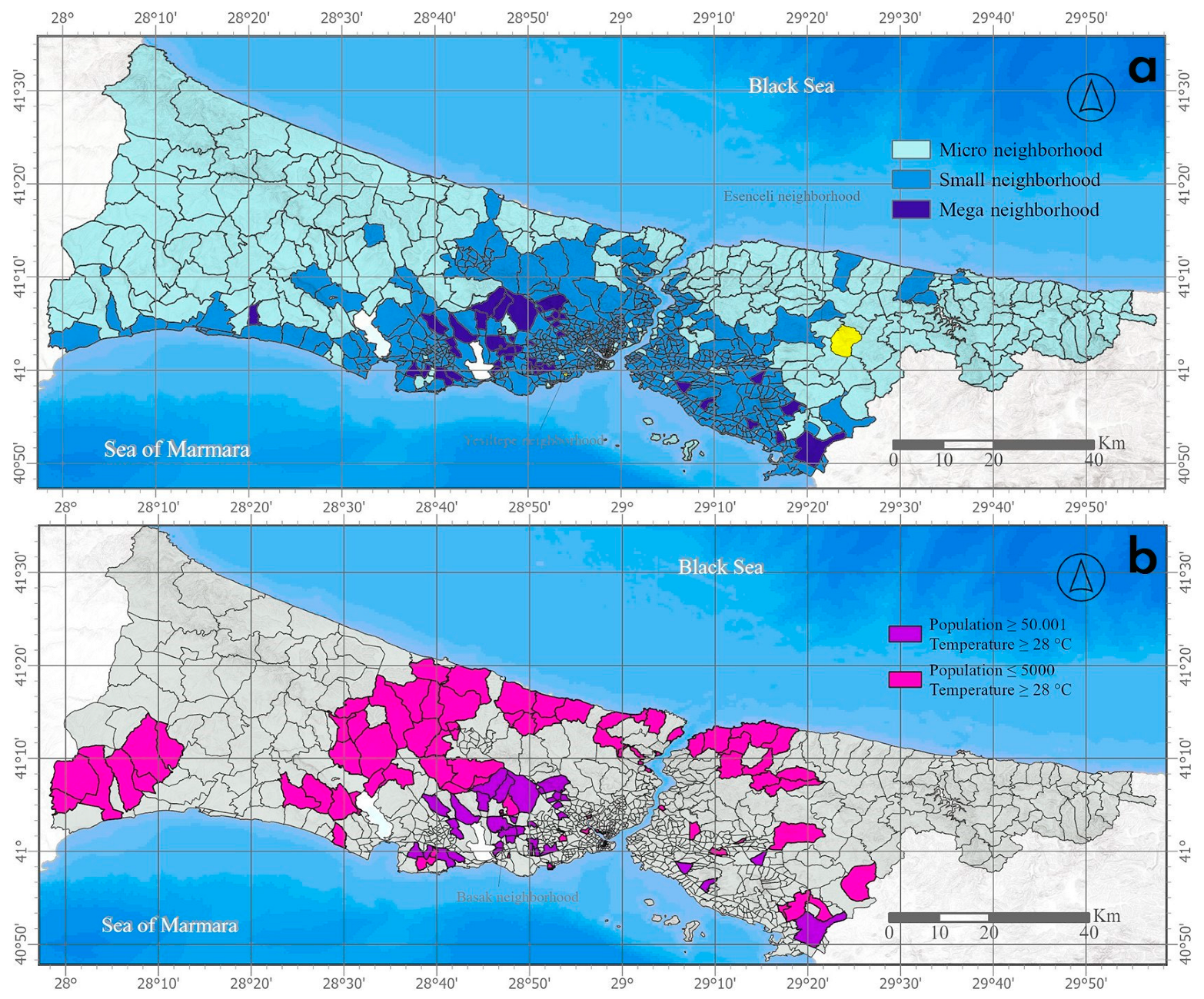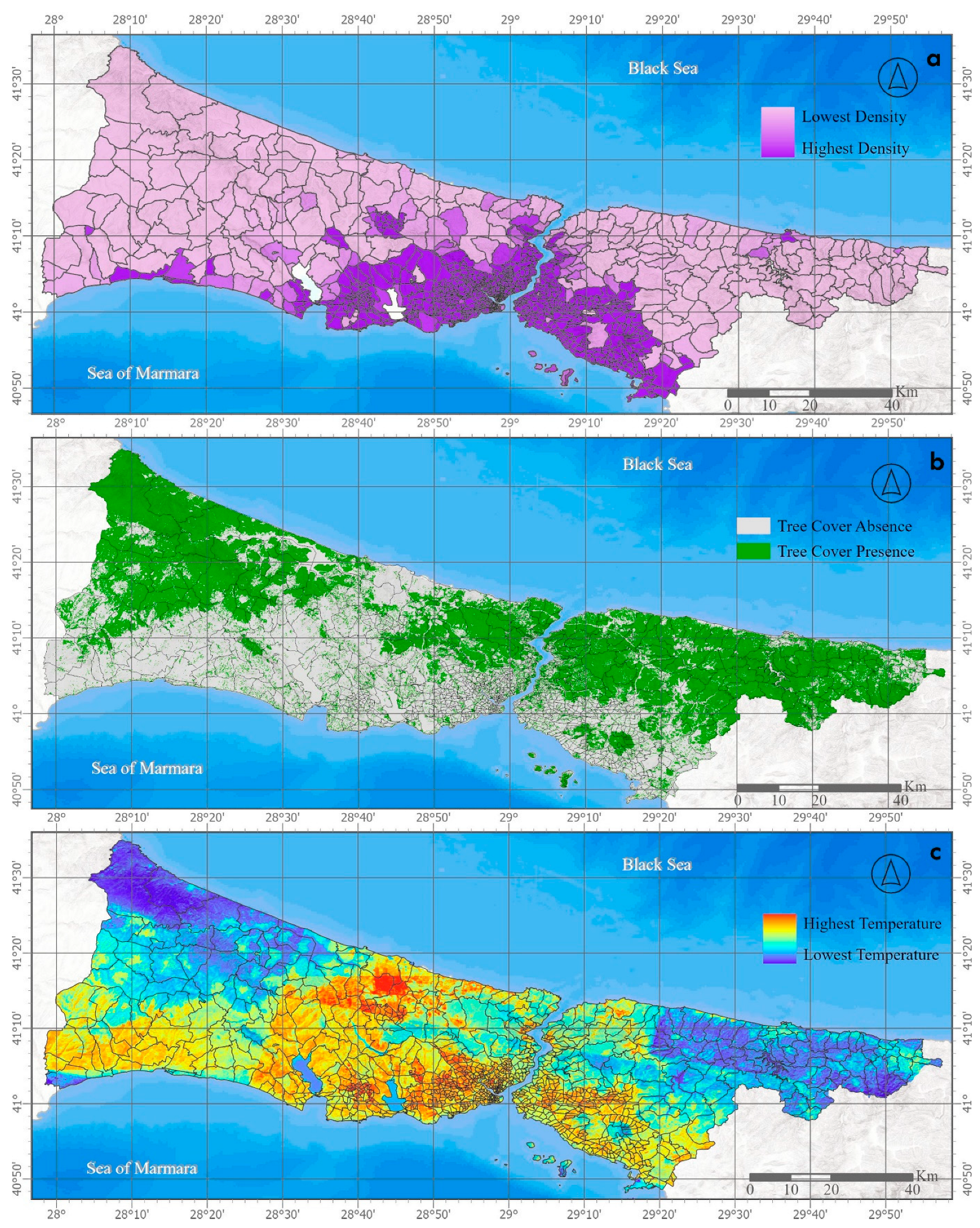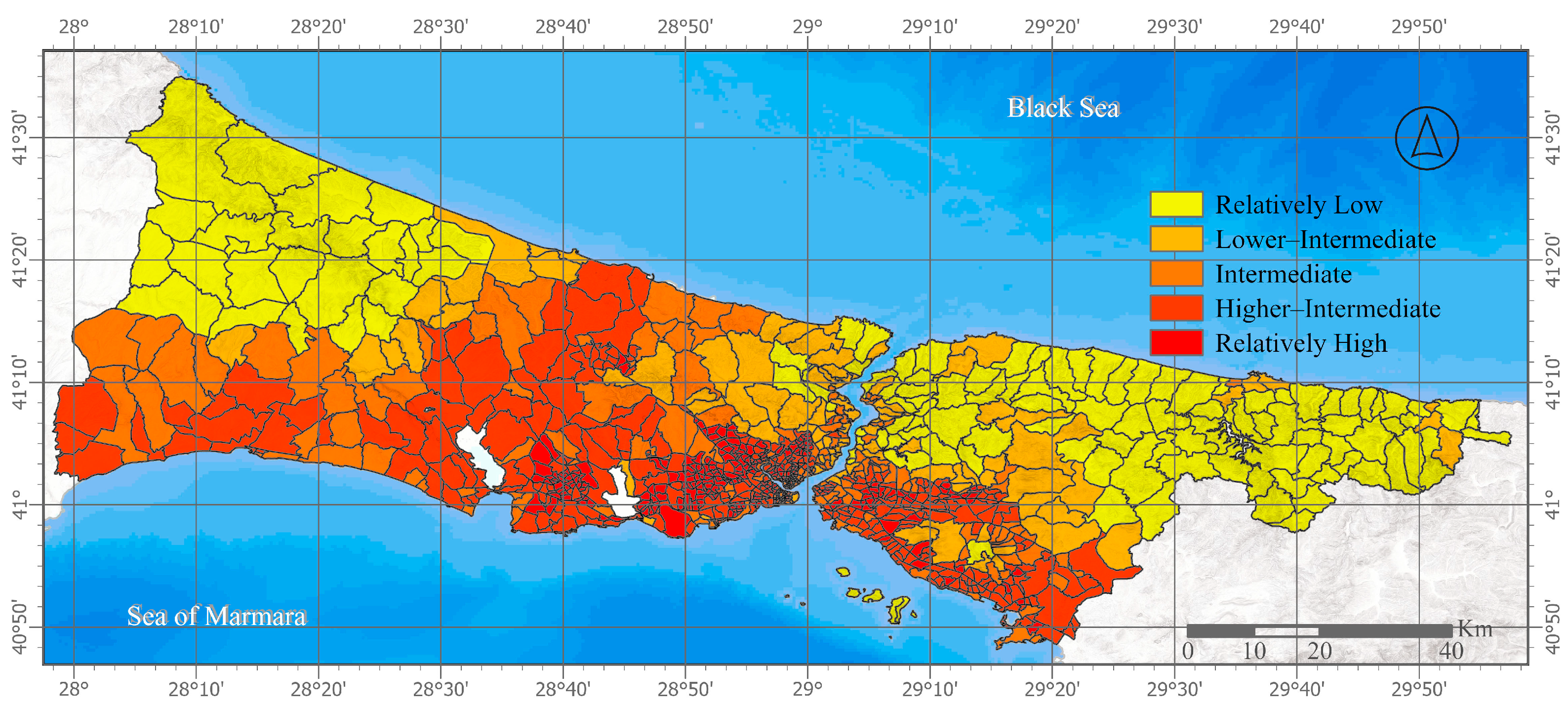Towards a Climate-Resilient Metropolis: A Neighborhood-Scale Nature-Based Urban Adaptation Planning Approach
Abstract
1. Introduction
2. Materials and Methods
2.1. Study Area
2.2. Methodology and Data Preparation
- -
- Existing tree canopy areas were identified in Step 2.
- -
- Forest lands designated by the General Directorate of Forestry were obtained in Step 3.
3. Results and Discussion
Limitations
4. Conclusions
Funding
Institutional Review Board Statement
Informed Consent Statement
Data Availability Statement
Acknowledgments
Conflicts of Interest
Abbreviations
| HRI | Heat Risk Index |
| LST | Land Surface Temperature |
| GIS | Geographic Information System |
| UNFCCC | United Nations Framework Convention on Climate Change |
| NUTS | Nomenclature of Territorial Units for Statistics |
| ESA | European Space Agency |
| CMCC | Euro-Mediterranean Center on Climate Change |
References
- UNFCCC. United Nations Framework Convention on Climate Change-Full Text of the Convention; UNFCCC: Bonn, Germany, 1992. [Google Scholar]
- Kalayci Kadak, M.; Ozturk, S.; Mert, A. Predicting Climate-Based Changes of Landscape Structure for Turkiye via Global Climate Change Scenarios: A Case Study in Bartin River Basin with Time Series Analysis for 2050. Nat. Hazards 2024, 120, 13289–13307. [Google Scholar] [CrossRef]
- Mert, A.; Tavuç, İ.; Özdemir, S.; Ulusan, M.D. Future Responses of the Burdur Lake to Climate Change and Uncontrolled Exploitation. J. Indian Soc. Remote Sens. 2025, 53, 1025–1036. [Google Scholar] [CrossRef]
- Harlan, S.L.; Brazel, A.J.; Prashad, L.; Stefanov, W.L.; Larsen, L. Neighborhood Microclimates and Vulnerability to Heat Stress. Soc. Sci. Med. 2006, 63, 2847–2863. [Google Scholar] [CrossRef]
- Yazdanirad, S.; Golbabaei, F.; Foroushani, A.R.; Monazzam, M.R.; Dehghan, H. Development and Validation of an Environmental Heat Strain Risk Assessment (EHSRA) Index Using Structural Equation Modeling Based on Empirical Relations. Environ. Health Prev. Med. 2020, 25, 63. [Google Scholar] [CrossRef] [PubMed]
- Lowry, S.J.; Blecker, H.; Camp, J.; De Castro, B.; Hecker, S.; Arbabi, S.; Traven, N.; Seixas, N.S. Possibilities and Challenges in Occupational Injury Surveillance of Day Laborers. Am. J. Ind. Med. 2010, 53, 126–134. [Google Scholar] [CrossRef] [PubMed]
- Tomlinson, C.J.; Chapman, L.; Thornes, J.E.; Baker, C.J. Including the Urban Heat Island in Spatial Heat Health Risk Assessment Strategies: A Case Study for Birmingham, UK. Int. J. Health Geogr. 2011, 10, 42. [Google Scholar] [CrossRef]
- Kalayci Kadak, M. Examination of Botanical Gardens as Urban Green and Open Spaces in Terms of Ecosystem Services: The Case of Iasi Botanical Garden, Romania. Anatol. J. For. Res. 2025, 11, 180–190. [Google Scholar] [CrossRef]
- Sarkar, S.M.; Dhar, B.K.; Fahlevi, M.; Ahmed, S.; Hossain, M.J.; Rahman, M.M.; Gazi, M.A.I.; Rajamani, R. Climate Change and Aging Health in Developing Countries. Glob. Chall. 2023, 7, 2200246. [Google Scholar] [CrossRef]
- Luber, G.; McGeehin, M. Climate Change and Extreme Heat Events. Am. J. Prev. Med. 2008, 35, 429–435. [Google Scholar] [CrossRef]
- Elmarakby, E.; Elkadi, H. Prioritising Urban Heat Island Mitigation Interventions: Mapping a Heat Risk Index. Sci. Total Environ. 2024, 948, 174927. [Google Scholar] [CrossRef]
- Ramírez-Aguilar, E.A.; Lucas Souza, L.C. Urban Form and Population Density: Influences on Urban Heat Island Intensities in Bogotá, Colombia. Urban Clim. 2019, 29, 100497. [Google Scholar] [CrossRef]
- Gokce, D.; Pancar, Z.B.; Turk, A. Determining the Spatial Vulnerability and Adaptation Capacity to Climate Change: A Case Study of Alanya. J. Grad. Sch. Nat. Appl. Sci. Mehmet Akif Ersoy Univ. 2018, 9, 119–128. [Google Scholar] [CrossRef]
- Liu, D.; Zhou, R.; Ma, Q.; He, T.; Fang, X.; Xiao, L.; Hu, Y.; Li, J.; Shao, L.; Gao, J. Spatio-Temporal Patterns and Population Exposure Risks of Urban Heat Island in Megacity Shanghai, China. Sustain. Cities Soc. 2024, 108, 105500. [Google Scholar] [CrossRef]
- Hoehne, C.G.; Hondula, D.M.; Chester, M.V.; Eisenman, D.P.; Middel, A.; Fraser, A.M.; Watkins, L.; Gerster, K. Heat Exposure during Outdoor Activities in the US Varies Significantly by City, Demography, and Activity. Health Place 2018, 54, 1–10. [Google Scholar] [CrossRef]
- Eisenman, D.P.; Wilhalme, H.; Tseng, C.H.; Chester, M.; English, P.; Pincetl, S.; Fraser, A.; Vangala, S.; Dhaliwal, S.K. Heat Death Associations with the Built Environment, Social Vulnerability and Their Interactions with Rising Temperature. Health Place 2016, 41, 89–99. [Google Scholar] [CrossRef]
- Bernhard, M.C.; Kent, S.T.; Sloan, M.E.; Evans, M.B.; McClure, L.A.; Gohlke, J.M. Measuring Personal Heat Exposure in an Urban and Rural Environment. Environ. Res. 2015, 137, 410–418. [Google Scholar] [CrossRef]
- Odame, E.A.; Li, Y.; Zheng, S.; Vaidyanathan, A.; Silver, K. Assessing Heat-Related Mortality Risks among Rural Populations: A Systematic Review and Meta-Analysis of Epidemiological Evidence. Int. J. Environ. Res. Public Health 2018, 15, 1597. [Google Scholar] [CrossRef] [PubMed]
- Lim, J.; Skidmore, M. Heat Vulnerability and Heat Island Mitigation in the United States. Atmosphere 2020, 11, 558. [Google Scholar] [CrossRef]
- Harlan, S.L.; Declet-Barreto, J.H.; Stefanov, W.L.; Petitti, D.B. Neighborhood Effects on Heat Deaths: Social and Environmental Predictors of Vulnerability in Maricopa County, Arizona. Environ. Health Perspect. 2013, 121, 197–204. [Google Scholar] [CrossRef] [PubMed]
- IPCC. Sixth Assessment Report (First Draft); IPCC: Geneva, Switzerland, 2021. [Google Scholar]
- Ebi, K.L.; Capon, A.; Berry, P.; Broderick, C.; de Dear, R.; Havenith, G.; Honda, Y.; Kovats, R.S.; Ma, W.; Malik, A.; et al. Hot Weather and Heat Extremes: Health Risks. Lancet 2021, 398, 698–708. [Google Scholar] [CrossRef]
- Faurie, C.; Varghese, B.M.; Liu, J.; Bi, P. Association between High Temperature and Heatwaves with Heat-Related Illnesses: A Systematic Review and Meta-Analysis. Sci. Total Environ. 2022, 852, 158332. [Google Scholar] [CrossRef]
- Gronlund, C.J.; Sullivan, K.P.; Kefelegn, Y.; Cameron, L.; O’Neill, M.S. Climate Change and Temperature Extremes: A Review of Heat- and Cold-Related Morbidity and Mortality Concerns of Municipalities. Maturitas 2018, 114, 54–59. [Google Scholar] [CrossRef]
- Yang, X.; Xu, X.; Wang, Y.; Yang, J.; Wu, X. Heat Exposure Impacts on Urban Health: A Meta-Analysis. Sci. Total Environ. 2024, 947, 174650. [Google Scholar] [CrossRef]
- Xu, C.; Wei, R.; Tong, H. A Systematic Review of Methodological Advances in Urban Heatwave Risk Assessment: Integrating Multi-Source Data and Hybrid Weighting Methods. Sustainability 2025, 17, 3747. [Google Scholar] [CrossRef]
- Shiva, J.S.; Chandler, D.G.; Kunkel, K.E. Mapping Heat Wave Hazard in Urban Areas: A Novel Multi-Criteria Decision Making Approach. Atmosphere 2022, 13, 1037. [Google Scholar] [CrossRef]
- Freitas, C.R.; Grigorieva, E.A. A Comparison and Appraisal of a Comprehensive Range of Human Thermal Climate Indices. Int. J. Biometeorol. 2017, 61, 487–512. [Google Scholar] [CrossRef]
- Johnson, D.P.; Wilson, J.S.; Luber, G.C. Socioeconomic Indicators of Heat-Related Health Risk Supplemented with Remotely Sensed Data. Int. J. Health Geogr. 2009, 8, 57. [Google Scholar] [CrossRef] [PubMed]
- Conti, S.; Meli, P.; Minelli, G.; Solimini, R.; Toccaceli, V.; Vichi, M.; Beltrano, C.; Perini, L. Epidemiologic Study of Mortality during the Summer 2003 Heat Wave in Italy. Environ. Res. 2005, 98, 390–399. [Google Scholar] [CrossRef] [PubMed]
- Maragno, D.; Fontana, M.D.; Musco, F. Mapping Heat Stress Vulnerability and Risk Assessment at the Neighborhood Scale to Drive Urban Adaptation Planning. Sustainability 2020, 12, 1056. [Google Scholar] [CrossRef]
- Groot-Reichwein, M.A.M.; van Lammeren, R.J.A.; Goosen, H.; Koekoek, A.; Bregt, A.K.; Vellinga, P. Urban Heat Indicator Map for Climate Adaptation Planning. Mitig. Adapt. Strateg. Glob. Change 2018, 23, 169–185. [Google Scholar] [CrossRef] [PubMed]
- An, H.; Cai, H.; Xu, X.; Qiao, Z.; Han, D. Impacts of Urban Green Space on Land Surface Temperature from Urban Block Perspectives. Remote Sens. 2022, 14, 4580. [Google Scholar] [CrossRef]
- Chen, Q.; Ding, M.; Yang, X.; Hu, K.; Qi, J. Spatially Explicit Assessment of Heat Health Risk by Using Multi-Sensor Remote Sensing Images and Socioeconomic Data in Yangtze River Delta, China. Int. J. Health Geogr. 2018, 17, 15. [Google Scholar] [CrossRef]
- Aung, T.H.; Tongleamnak, S.; Suwanwerakamtorn, R. Spatiotemporal Patterns of Land Surface Temperature, Urban Heat Island, and Potential Heat Stress Risk Areas Assessment for Tropical Inland City and Coastal City in Thailand. Appl. Environ. Res. 2024, 46, 43. [Google Scholar] [CrossRef]
- Abulibdeh, A. Analysis of Urban Heat Island Characteristics and Mitigation Strategies for Eight Arid and Semi-Arid Gulf Region Cities. Environ. Earth Sci. 2021, 80, 259. [Google Scholar] [CrossRef] [PubMed]
- Dechao, C.; Xu, X.; Sun, Z.; Liu, L.; Qiao, Z.; Huang, T. Assessment of Urban Heat Risk in Mountain Environments: A Case Study of Chongqing Metropolitan Area, China. Sustainability 2020, 12, 309. [Google Scholar] [CrossRef]
- Rahimi, E.; Barghjelveh, S.; Dong, P. Quantifying How Urban Landscape Heterogeneity Affects Land Surface Temperature at Multiple Scales. J. Ecol. Environ. 2021, 45, 22. [Google Scholar] [CrossRef]
- Taloor, A.K.; Parsad, G.; Jabeen, S.F.; Sharma, M.; Choudhary, R.; Kumar, A. Analytical Study of Land Surface Temperature for Evaluation of UHI and UHS in the City of Chandigarh India. Remote Sens. Appl. Soc. Environ. 2024, 35, 101206. [Google Scholar] [CrossRef]
- Harlan, S.L.; Ruddell, D.M. Climate Change and Health in Cities: Impacts of Heat and Air Pollution and Potential Co-Benefits from Mitigation and Adaptation. Curr. Opin. Environ. Sustain. 2011, 3, 126–134. [Google Scholar] [CrossRef]
- Acarer, A.; Mert, A. 21st Century Climate Change Threatens on the Brown Bear. Cerne 2024, 30, e-103305. [Google Scholar] [CrossRef]
- IPCC. Climate Change 2022: Impacts, Adaptation and Vulnerability; IPCC: Geneva, Switzerland, 2022. [Google Scholar]
- Gul, E. On the Edge of Survival: The Fragile Fate of Scots Pine (Pinus sylvestris L.) in Central Anatolia, Türkiye Under Climate Change. BioResources 2025, 20, 3628–3652. [Google Scholar] [CrossRef]
- Acarer, A.; Mert, A. Mapping Habitat Suitability of the Brown Bear in Artvin-Şavşat Region, Turkey. Ursus 2025, 2025, 1–15. [Google Scholar] [CrossRef]
- Hopke, J.E. Connecting Extreme Heat Events to Climate Change: Media Coverage of Heat Waves and Wildfires. Environ. Commun. 2020, 14, 492–508. [Google Scholar] [CrossRef]
- Bai, T.; Fan, L.; Song, G.; Song, H.; Ru, X.; Wang, Y.; Zhang, H.; Min, R.; Wang, W. Effects of Land Use/Cover and Meteorological Changes on Regional Climate under Different SSP-RCP Scenarios: A Case Study in Zhengzhou, China. Remote Sens. 2023, 15, 2601. [Google Scholar] [CrossRef]
- Tian, L.; Tao, Y.; Li, M.; Qian, C.; Li, T.; Wu, Y.; Ren, F. Prediction of Land Surface Temperature Considering Future Land Use Change Effects under Climate Change Scenarios in Nanjing City, China. Remote Sens. 2023, 15, 2914. [Google Scholar] [CrossRef]
- Hong, T.; Wu, J.; Kang, X.; Yuan, M.; Duan, L. Impacts of Different Land Use Scenarios on Future Global and Regional Climate Extremes. Atmosphere 2022, 13, 995. [Google Scholar] [CrossRef]
- TÜİK Address-Based Population Registration System. Available online: https://biruni.tuik.gov.tr/medas/?kn=95&locale=tr (accessed on 1 July 2025).
- CMCC. G20 Climate Risk Atlas: Impacts, Policy, Economics; CMCC: Lecce, Italy, 2021. [Google Scholar]
- Boluk, E.; Eskioglu, O.; Çalık, Y.; Yagan, S. Köppen İklim Sınıflandırmasına Göre Türkiye İklimi; 2023. Available online: https://www.mgm.gov.tr/files/iklim/iklim_siniflandirmalari/koppen.pdf (accessed on 20 June 2025).
- ESA WorldCover 2021 Product User Manual (PUM). Available online: https://worldcover2021.esa.int/data/docs/WorldCover_PUM_V2.0.pdf (accessed on 18 May 2025).
- Edmondson, J.L.; Stott, I.; Davies, Z.G.; Gaston, K.J.; Leake, J.R. Soil Surface Temperatures Reveal Moderation of the Urban Heat Island Effect by Trees and Shrubs. Sci. Rep. 2016, 6, 33708. [Google Scholar] [CrossRef]
- Ziter, C.D.; Pedersen, E.J.; Kucharik, C.J.; Turner, M.G. Scale-Dependent Interactions between Tree Canopy Cover and Impervious Surfaces Reduce Daytime Urban Heat during Summer. Proc. Natl. Acad. Sci. USA 2019, 116, 7575–7580. [Google Scholar] [CrossRef]
- Armson, D.; Stringer, P.; Ennos, A.R. The Effect of Tree Shade and Grass on Surface and Globe Temperatures in an Urban Area. Urban For. Urban Green. 2012, 11, 245–255. [Google Scholar] [CrossRef]
- ESA WorldCover Algorithm Theoretical Basis Document (ATBD). Available online: https://climate.esa.int/media/documents/CCI-LAKES-0024-ATBD-v2.3.pdf (accessed on 18 May 2025).
- Cheng, Z.; Nesbitt, L.; Girling, C.; Sheppard, S.; Konijnendijk, C.; Nitoslawski, S. Urban Density and the Urban Forest: How Well Are Cities Balancing Them in the Context of Climate Change? Cities 2024, 149, 104962. [Google Scholar] [CrossRef]
- Bille, R.A.; Jensen, K.E.; Buitenwerf, R. Global Patterns in Urban Green Space Are Strongly Linked to Human Development and Population Density. Urban For. Urban Green. 2023, 86, 127980. [Google Scholar] [CrossRef]
- Mohammed, A.M.S. The Heat Adaptation Priority Index (HAPI): A Practical Tool for Urban Heat Risk Assessment and Mitigation Priority. Sustain. Cities Soc. 2025, 126, 106420. [Google Scholar] [CrossRef]
- Kestens, Y.; Brand, A.; Fournier, M.; Goudreau, S.; Kosatsky, T.; Maloley, M.; Smargiassi, A. Modelling the Variation of Land Surface Temperature as Determinant of Risk of Heat-Related Health Events. Int. J. Health Geogr. 2011, 10, 7. [Google Scholar] [CrossRef] [PubMed]
- ESRI Inc. Multispectral Landsat. Available online: https://landsat2.arcgis.com/arcgis/rest/services/Landsat/MS/ImageServer (accessed on 8 July 2025).
- U.S. Geological Survey. Landsat 8 (L8) Data Users Handbook; U.S. Geological Survey: Sioux Falls, SD, USA, 2019.
- Ermida, S.L.; Soares, P.; Mantas, V.; Göttsche, F.M.; Trigo, I.F. Google Earth Engine Open-Source Code for Land Surface Temperature Estimation from the Landsat Series. Remote Sens. 2020, 12, 1471. [Google Scholar] [CrossRef]
- Sobrino, J.A.; Raissouni, N. Toward Remote Sensing Methods for Land Cover Dynamic Monitoring: Application to Morocco. Int. J. Remote Sens. 2000, 21, 353–366. [Google Scholar] [CrossRef]
- ESRI Inc. ArcGIS Arcade. Available online: https://developers.arcgis.com/arcade/ (accessed on 8 July 2025).
- General Directorate of State Airports Authority Istanbul Havalimanı Zirvede. Available online: https://www.dhmi.gov.tr/Sayfalar/Haber/istanbul-havalimani-zirvede.aspx (accessed on 30 June 2025).
- Yang, M.; Ren, C.; Wang, H.; Wang, J.; Feng, Z.; Kumar, P.; Haghighat, F.; Cao, S.-J. Mitigating Urban Heat Island through Neighboring Rural Land Cover. Nat. Cities 2024, 1, 522–532. [Google Scholar] [CrossRef]
- Turkish Statistical Institute Population and Demography. Turkish Statistical Institute Data Portal for Statistics. Available online: https://data.tuik.gov.tr/Kategori/GetKategori?p=nufus-ve-demografi-109&dil=2 (accessed on 20 June 2025).
- Alessandrini, A.; Deuster, C.; Dijkstra, L.; Ghio, D.; Natale, F. Rethinking City Population Growth: How Reclassification Matters. Popul. Dev. Rev. 2024, 50, 997–1015. [Google Scholar] [CrossRef]
- Alexander, C. Influence of the Proportion, Height and Proximity of Vegetation and Buildings on Urban Land Surface Temperature. Int. J. Appl. Earth Obs. Geoinf. 2021, 95, 102265. [Google Scholar] [CrossRef]
- Ghobadi, Y.; Pradhan, B.; Shafri, H.Z.M.; Kabiri, K. Assessment of Spatial Relationship between Land Surface Temperature and Landuse/Cover Retrieval from Multi-Temporal Remote Sensing Data in South Karkheh Sub-Basin, Iran. Arab. J. Geosci. 2015, 8, 525–537. [Google Scholar] [CrossRef]
- Khorrami, B.; Heidarlou, H.B.; Feizizadeh, B. Evaluation of the Environmental Impacts of Urbanization from the Viewpoint of Increased Skin Temperatures: A Case Study from Istanbul, Turkey. Appl. Geomatics 2021, 13, 311–324. [Google Scholar] [CrossRef]
- Istanbul Metropolitan Municipality. İstanbul İklim Değişikliği Eylem Planı; Istanbul Metropolitan Municipality: İstanbul, Turkey, 2021. [Google Scholar]
- Kara, Y.; Yavuz, V. Urban Microclimates in a Warming World: Land Surface Temperature (LST) Trends Across Ten Major Cities on Seven Continents. Urban Sci. 2025, 9, 115. [Google Scholar] [CrossRef]
- Kalayci Kadak, M. A Suitable Model Proposal via Remote Sensing and Geographic Information Systems in the Bartın Stream Basin for Climate Change Scenarios; Kastamonu University Graduate School of Natural and Applied Sciences: Kastamonu, Turkey, 2021. [Google Scholar]
- Turkes, M. IPCC’nin Yeni Yayımlanan İklim Değişikliğinin Etkileri, Uyum ve Etkilenebilirlik Raporu Bize Neler Söylüyor? Resilience 2022, 6, 197–207. [Google Scholar] [CrossRef]
- Hirsch, A.L.; Ridder, N.N.; Perkins-Kirkpatrick, S.E.; Ukkola, A. CMIP6 MultiModel Evaluation of Present-Day Heatwave Attributes. Geophys. Res. Lett. 2021, 48, e2021GL095161. [Google Scholar] [CrossRef]
- Funsten, C.; Di Franco, C.; Borsellino, V.; Surano, N.; Asciuto, A.; Schimmenti, E. The Recreational Value of Botanic Garden Events: A Case Study of the Zagara Plant Fair in Palermo, Italy. J. Outdoor Recreat. Tour. 2022, 39, 100565. [Google Scholar] [CrossRef]
- Fischer, E.M.; Oleson, K.W.; Lawrence, D.M. Contrasting Urban and Rural Heat Stress Responses to Climate Change. Geophys. Res. Lett. 2012, 39, L03705. [Google Scholar] [CrossRef]
- Unal, Y.S.; Sonuc, C.Y.; Incecik, S.; Topcu, H.S.; Diren-Ustun, D.H.; Temizoz, H.P. Investigating Urban Heat Island Intensity in Istanbul. Theor. Appl. Climatol. 2020, 139, 175–190. [Google Scholar] [CrossRef]
- Kong, J.; Zhao, Y.; Carmeliet, J.; Lei, C. Urban Heat Island and Its Interaction with Heatwaves: A Review of Studies on Mesoscale. Sustainability 2021, 13, 10923. [Google Scholar] [CrossRef]
- Kiarsi, M.; Amiresmaili, M.; Mahmoodi, M.R.; Farahmandnia, H.; Nakhaee, N.; Zareiyan, A.; Aghababaeian, H. Heat Waves and Adaptation: A Global Systematic Review. J. Therm. Biol. 2023, 116, 103588. [Google Scholar] [CrossRef] [PubMed]
- Connelly, R.I.; Bal, P.G. Local Networks of Resilience and Climate Adaptation: The Case of Istanbul. In Climate Change Adaptation, Resilience and Hazards; Springer: Cham, Switzerland, 2016; pp. 109–123. ISBN 9783319398792. [Google Scholar]
- Kuru, A.; Begen Okay, B. Investigating the Relationship between Urban Growth Pattern and Urban Heat Islands: The Case of Istanbul, Turkey. Environ. Earth Sci. 2025, 84, 43. [Google Scholar] [CrossRef]
- Rizwan, A.M.; Dennis, L.Y.C.; Liu, C. A Review on the Generation, Determination and Mitigation of Urban Heat Island. J. Environ. Sci. 2008, 20, 120–128. [Google Scholar] [CrossRef]
- MoEUCC-DCC. İklim Değişikliğine Uyum Stratejisi ve Eylem Planı (2024–2030); 2024. Available online: https://iklim.gov.tr/db/turkce/icerikler/files/%C4%B0klim%20De%C4%9Fi%C5%9Fikli%C4%9Fine%20Uyum%20Stratejisi%20ve%20Eylem%20Plan_%202024-2030.pdf (accessed on 8 July 2025).
- Wang, J.; Zhou, W.; Li, H.; Xu, L.; Wang, H. Cooling Benefits from Urban Planting Depend on Local Background Canopy Cover: A Continental Cross-City Comparison. Sci. Total Environ. 2024, 955, 176864. [Google Scholar] [CrossRef] [PubMed]
- Guo, A.; He, T.; Yue, W.; Xiao, W.; Yang, J.; Zhang, M.; Li, M. Contribution of Urban Trees in Reducing Land Surface Temperature: Evidence from China’s Major Cities. Int. J. Appl. Earth Obs. Geoinf. 2023, 125, 103570. [Google Scholar] [CrossRef]
- Yang, Q.; Huang, X.; Tong, X.; Xiao, C.; Yang, J.; Liu, Y.; Cao, Y. Global Assessment of Urban Trees’ Cooling Efficiency Based on Satellite Observations. Environ. Res. Lett. 2022, 17, 034029. [Google Scholar] [CrossRef]
- Mandvikar, K.; Kumar, N.; Supe, H.; Singh, D.; Gupta, A.; Kumar, P.; Meraj, G.; Khan, I.D.; Kouser, A.; Pandey, S.K.; et al. Evaluating Heat Health Risk in Indian Cities: Geospatial and Socio-Ecological Analysis. World Dev. Sustain. 2024, 5, 100180. [Google Scholar] [CrossRef]






Disclaimer/Publisher’s Note: The statements, opinions and data contained in all publications are solely those of the individual author(s) and contributor(s) and not of MDPI and/or the editor(s). MDPI and/or the editor(s) disclaim responsibility for any injury to people or property resulting from any ideas, methods, instructions or products referred to in the content. |
© 2025 by the author. Licensee MDPI, Basel, Switzerland. This article is an open access article distributed under the terms and conditions of the Creative Commons Attribution (CC BY) license (https://creativecommons.org/licenses/by/4.0/).
Share and Cite
Kalaycı Kadak, M. Towards a Climate-Resilient Metropolis: A Neighborhood-Scale Nature-Based Urban Adaptation Planning Approach. Sustainability 2025, 17, 7356. https://doi.org/10.3390/su17167356
Kalaycı Kadak M. Towards a Climate-Resilient Metropolis: A Neighborhood-Scale Nature-Based Urban Adaptation Planning Approach. Sustainability. 2025; 17(16):7356. https://doi.org/10.3390/su17167356
Chicago/Turabian StyleKalaycı Kadak, Merve. 2025. "Towards a Climate-Resilient Metropolis: A Neighborhood-Scale Nature-Based Urban Adaptation Planning Approach" Sustainability 17, no. 16: 7356. https://doi.org/10.3390/su17167356
APA StyleKalaycı Kadak, M. (2025). Towards a Climate-Resilient Metropolis: A Neighborhood-Scale Nature-Based Urban Adaptation Planning Approach. Sustainability, 17(16), 7356. https://doi.org/10.3390/su17167356





